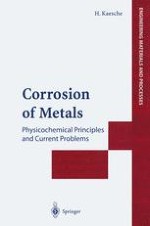2003 | OriginalPaper | Chapter
Hydrogen Embrittlement
Author : Prof. em. Dr. rer. nat. Helmut Kaesche
Published in: Corrosion of Metals
Publisher: Springer Berlin Heidelberg
Included in: Professional Book Archive
Activate our intelligent search to find suitable subject content or patents.
Select sections of text to find matching patents with Artificial Intelligence. powered by
Select sections of text to find additional relevant content using AI-assisted search. powered by
An important danger to structural materials subject to tensile load is unexpected brittle, instead of usually predictable ductile, fracture, and a notorious variety is embrittlement by uptake of atomic hydrogen as a solute in the metal lattice. Since ductility of metals is caused by dislocations moving in stress fields, hydrogen embrittlement usually is an effect of interaction of absorbed hydrogen with dislocations. The subject and its implications are vast, and we shall not go into many details, referring the reader to competent reviews [2]. Hydrogen embrittlement is not, however, always caused by hydrogen/dislocation interaction. Atomic hydrogen, if dissolved to high concentration or high thermodynamic activity, also can recombine at internal surfaces to molecular gaseous hydrogen at high pressure, and the combination of the two effects tends to very much complicate the situation [3]. Therefore, the two limiting cases of pure effects: a) high-pressure internal molecular hydrogen and b) dissolved atomic hydrogen, will be briefly introduced presently, postponing the description of details to later sections. For the limiting cases, the main principles are, in fact, well understood and well documented [3-5].
